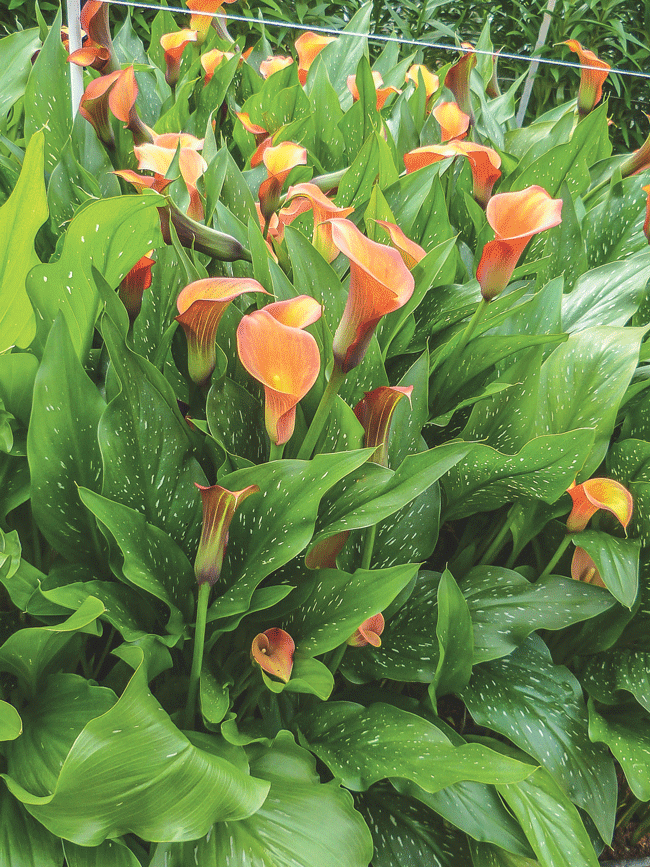
Flowering Tropical Foliage Landscape
Calla Lily
Zantedeschia hybrida
Calla Lily
Zantedeschia hybrida
Care & Maintenance
Plant Code:
LW00678
Light:
Part Sun - Morning Sunlight Only
Water:
Moist
Bloom Time:
Spring Summer
Flower Color:
Multicolor
Average Size:
24-36" H x 12" W
Spacing:
12-18"
Cold Hardiness:
Zone 9 (30 to 20°F)
About This Plant
- Most tropical plants need a frost free environment to successfully overwinter and be used as permanent plants in the garden. Geographically this leaves most areas of North America, except USDA cold hardines zones 10 and 11, unsuitable for reliably growing tropical plants as year-around permanent landscape addtions. However, that does not mean you can't enjoy tropical plants during the warm growing season as annuals (re-planted each year) or as container plants that are overwintered indoors.
- Adding tropical plants to traditional annual or perennial plantings, outside their natural cold hardy range, is an exciting new trend in garden design. A mixture or mass planting of exotic tropicals with huge shiny leaves, bold outrageous colors, ferny textures, and spectacular flowers can transform the ho hum summertime landscape. A big plus is that topicals love the heat when other plants fizzle.
- Containerized plants can be placed on patios, decks and around pools. Planting in containers makes it much easier to move inside for the winter if you desire or simply replant next season.
- Flowering plants, prized for their outstanding show of blooms, should be a part of every landscape. Use a single specimen to brighten a shady spot or plant in mass for a burst of color. Utilize varieties with different bloom times to brighten the landscape all season long. Plant flowering plants in highly visible areas where they can be enjoyed. Utilize green-leafed plants as a background to make the flowers stand out where possible. Evergreen flowering plants maintain their leaves year around while deciduous varieties loose their leaves in the fall and re-leaf in the spring.
Additional Information
Successful growing requires excellent drainage.
Uses
Cut Flower, Container, Beds and Borders, Mass Planting, Houseplant, Ponds and Bogs
Attributes
- Exotic pastel blooms
- Superb cut flowers
- Seasonal annual or houseplant
- Blooms spring to summer
How to Water
- New plants require more frequent watering than established plants. After planting check for water regularly until fully rooted and established.
- For large plants; build a soil ring around the plant to use as a water reservoir. This will assist in watering until the plant is established.
- Always water slowly and deeply making sure the root ball is completely saturated.
- Don't water at night if possible. Watering in the morning helps prevent disease.
- If new plant wilts between watering, increase the frequency of watering.
- Plants in hot, humid or sunny areas need more frequent watering than plants in cool climates.
- Plants in containers may require more frequent watering than plants in the ground. This will depend on plant variety, pot size and soil.
- Add a 2-3"" layer of organic mulch around plant to maintain and conserve soil moisture. Mulch will reduce watering frequency and speed root establishment.
How to Plant
- Prepare the area for planting by conditioning the soil. Loosen the soil and incorporate an organic soil conditioner according to directions. Bone meal and super phosphate can also be incorporated to promote flowers and root growth.
- Plant spring blooming bulbs in the fall. Summer blooming bulbs should be planted in the spring.
- Different varieties of bulbs have different planting depths and planting instructions. Follow planting directions on the bulb package.
- Backfill soil mix around bulbs to ground level and tamp lightly removing all air pockets.
- Water to settle the soil around the bulb. Add more soil mix around bulb if necessary after watering. While the bulb is dormant, little water is required.
- Add a 2-3" layer of mulch around plant to conserve soil moisture and eliminate future weeds.
How to Fertilize
- Fertilize just before and during the plants active growing cycle. Fertilization should begin just prior to new growth and end three or four weeks before the first frost.
- Choose an all-purpose fertilizer recommended for flowering and/or foliage plants. Frequency will depend on the type of fertilizer. Liquid (water soluble) and granular quick release fertilizer, require more frequent application; slow release granular fertilizer requires less.
- When using granular fertilizer be sure to sprinkle fertilizer pellets away from the plant stems or trunk to prevent possible burning and always water thoroughly after application. This dissolves or releases the fertilizer into the soil. Apply water soluble fertilizer by thoroughly drenching the leaves and soil.
- Always follow fertilizer package directions.
How to Prune
- Prune as required to keep plants a desired size or shape.
- Encourage new blooms by cutting off dead or faded flowers.
- Plants with branches originating from the roots of the plant need to be selectively pruned. Prune by removing the oldest branches completely. This will allow new, more productive branches to develop and produce flowers.
- Remove damaged or dead limbs back to live wood.
- When pruning, make angled cuts just above the bud.
- Use proper tools such as shears, hand pruners, pole pruners and pruning saws. Make sure all equipment is clean and sharp.
- Fertilize after pruning to help speed new growth.
Resource Center
Product Checklist
- Planting MixPromotes strong healthy growth and more flowers
- Potting SoilReady to use mix for indoor and outdoor containers and hanging baskets
- Plant StarterHelps plants quickly establish to their new home
- Slow Release FertilizerFeeds for months with one application. Safe to use on new plantings
- Organic MulchPrevents weeds for months, saves water and beautifies
- Planting ToolsShovels, trowels, cultivators and other tools to make planting easy
- Pre-emergent Weed ControlApply to ground after planting to prevent new weeds from sprouting
- Soaker HoseEasy to use, conserves water, and reduces chance of leaf diseases
- ContainersChoose from light weight resin, clay or ceramic for patio or porch
- Landscape EdgingKeeps beds defined, easy to maintain, and free of lawn grass
- Hedge or Pruning ShearsRegular pruning keeps shrubs full and promotes more flowers


 We could not acquire a location at this time.
We could not acquire a location at this time.


